Creepy, crawly, slithering snakes!
Legless though they are, that just means they can get into places we can’t to go after rodents. After all, who wants mice in the walls?
These rodent-eating machines are everywhere. So learning to tell which snakes are dangerous and which are just garden helpers will keep you from worrying too much.
Pit Viper Basics
Since three of the top five snakes spotted in Arizona are rattlesnakes, a basic pit viper introduction seems wise!
Pit vipers are part of the Viperidae subfamily of Crotalinae, which comes from a Greek word that means rattle. Pit vipers have a heat-sensitive loreal pit between their nostril and eye. Their pits face forward, allowing them to “see” heat in the dark. They’re so precise that they can strike accurately with no light.
Rattlesnakes are pit vipers in either the Crotalus genus or Sistrurus. They give birth to live babies in early to mid-summer; many rattlesnake moms protect their babies for the first couple of weeks after birth. In some species, they even herd the little ones back in position behind them. In addition, many species use the same brumation (reptile hibernation) dens from one generation to the next.
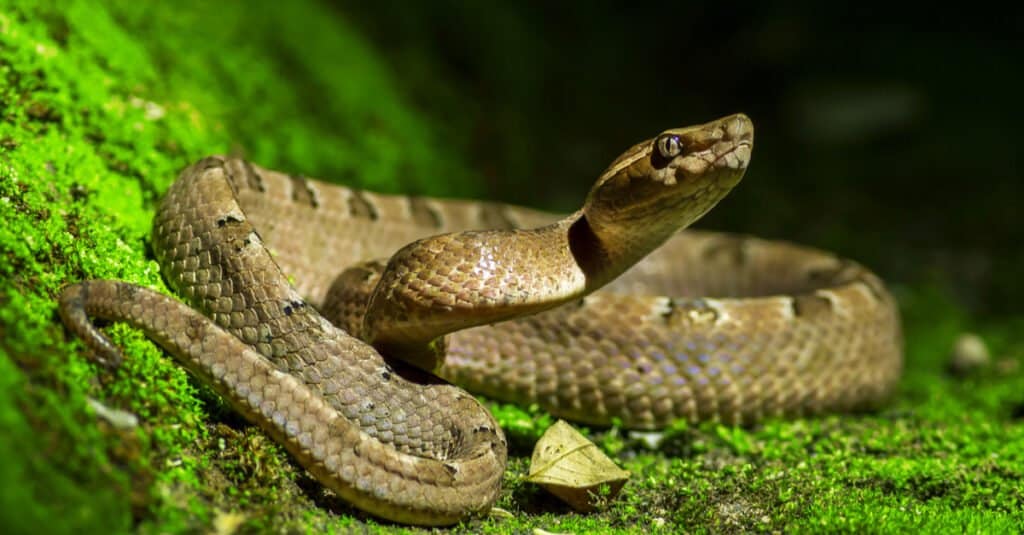
Pit vipers have a heat-sensitive loreal pit between their nostril letting them “see” heat in the dark so they can strike accurately with no light.
©Worraket/Shutterstock.com
Venomous Snakes in Arizona
If you love venomous snakes, Arizona is the place! The Grand Canyon State boasts the largest number of venomous snake species in the U.S., with 13 rattlesnake species! Also found in the state is the Sonoran coral snake, and several harmless to us but mildly venomous snakes.
Along with having the most venomous snakes of any U.S. state, Arizona has more native rattlesnakes than any other state.
Most Common Garden Snake in Arizona: Western Diamondback Rattlesnake (Crotalus atrox)
I’m not surprised that Arizona’s most commonly sighted snake is the western diamondback rattlesnake.
However, it’s probably not in the middle of Phoenix. No, this snake usually shuns human habitats. Instead, look around the edges of neighborhoods where the roads and homes butt up against undeveloped regions, newer communities where the wildlife is recently displaced, and the rocky, craggy hills.
Western diamondback rattlesnakes have black and white banding on their tails before their rattles, leading to the nickname “coon tail.” They typically grow to about four feet long but can rarely reach seven feet. These snakes often match their habitat, with dusty reds and browns in their markings. Dorsally, they have diamond-shaped blotches with dark edges and pale cream outlines; these are set over a lighter base color.
These ambush predators use the “sit and wait” approach to hunting. It’s an approach that they also use to hide from potential threats. When they realize they’ve been seen, these snakes often raise their heads into a striking position and rattle as they back away.
Western diamondback rattlesnakes cause a large portion of all rattlesnake bites each year.
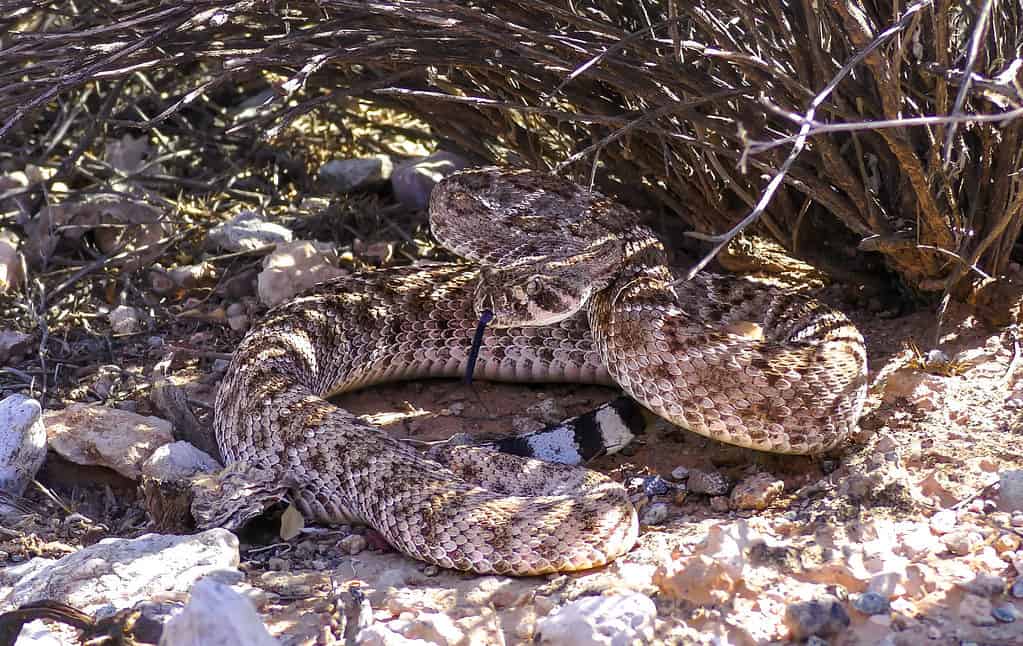
Western diamondback rattlesnakes have black and white banding on their tails before their rattles, leading to the nickname “coon tail.”
©iStock.com/Banu R
Western Black-Tailed Rattlesnake (Crotalus molossus)
After the western diamondback rattlesnake, Arizona’s second most common venomous snake is the western black-tailed rattlesnake. This snake is relatively large and reaches up to four feet long.
The western black-tailed rattlesnake has a solid black or dark brown tail. In addition, it has dark, jagged blotches on its back over a lighter gray, brown, or golden yellow color. This snake uses its rattle to warn away threats and is quick to rattle at the first hint of danger.
This species is common across nearly all of southern and western Arizona. It occurs in various habitats, from desert scrub to woodlands, where it seems most prevalent. The western black-tailed rattlesnake is active at any time during the day or night when the temperatures are favorable.
If your garden is on the edges of these areas, there’s a strong possibility you’ll run across one of these guys at some point.
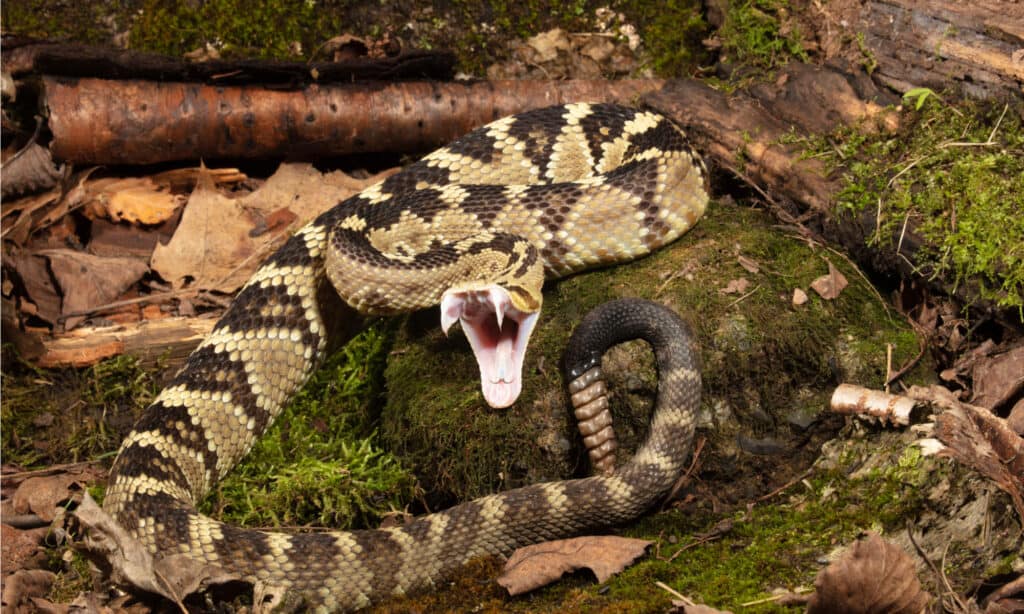
Arizona’s second most common venomous snake is the western black-tailed rattlesnake.
©Joe McDonald/Shutterstock.com
Mojave Rattlesnake (Crotalus scutulatus)
Although the Mojave rattlesnake is only the third most common in Arizona, it’s exceptionally venomous. It’s one of few rattlesnakes with a crazy venom combination of neurotoxic and hemotoxic venoms that do a job on people. However, the venom combination varies depending on where in the snake’s range you’re looking.
This species grows to about four feet long or a little more. Mojave rattlesnakes are gray-brown, tan, or olive-colored with dark blotches that run down the back to their tail, which morph into crossbands where the white sections are bigger than the dark.
It prefers high desert and lower mountainsides and often hangs out near scrub brush. Most people encounter them in more rural areas. This species is most active at night, so you’re not as likely to encounter it; and like its cousins, the Mojave rattlesnake prefers to stay away from people.

The Mojave rattlesnake is one of few rattlesnakes with a combination of neurotoxic and hemotoxic venoms.
©iStock.com/Shoemcfly
Other Venomous Arizona Snakes
As I mentioned earlier, Arizona has the most venomous snakes of any U.S. state. Here are a few more that are dangerous to people and pets, in order of sightings reported on iNaturalist.org:
- Sidewinder (Crotalus cerastes)
- Tiger rattlesnake (Crotalus tigris)
- Southwestern speckled rattlesnake (Crotalus pyrrhus)
- Arizona black rattlesnake (Crotalus cerberus)
- Rock rattlesnake (Crotalus lepidus)
- Sonoran coral snake (Micruroides euryxanthus)
- Prairie rattlesnake (Crotalus viridis)
- Ridge-nosed rattlesnake (Crotalus willardi)
- Great basin rattlesnake (Crotalus oreganus lutosis)
- Twin-spotted rattlesnake (Crotalus pricei)
- Western Massasauga (Sistrurus tergeminus)
Most Common Nonvenomous Snake in Arizona Gardens: Gopher Snake (Pituophis catenifer ssp.)
Our next legless rodent-eating buddy is the gopher snake. According to iNaturalist.org, gopher snakes are the most common nonvenomous snake and the second most common snake in Arizona overall.
Gopher snakes have round pupils and reddish-brown, black, olive, or brown blotches along their back; at their necks and tails, the blotches are surrounded by little spots, splotches, and dashes. Its base color varies and can be pale gray, orange-brown, yellow, tan, or cream.
Arizona’s longest snake often reaches nearly eight feet long. There are multiple gopher snake subspecies spread across most of North America. Gopher snakes occur nearly everywhere in Arizona and don’t even mind being in and around people.
Gopher snakes are adaptable and make their homes just about everywhere. They are active whenever the temperatures are favorable, day or night.
When cornered, they bluff like mad! These snakes rise up into a striking position, flatten their heads, hiss loudly and vibrate their tails. Many innocent gopher snakes have been mistaken for rattlesnakes because of their dramatic behavior, but they’re harmless!
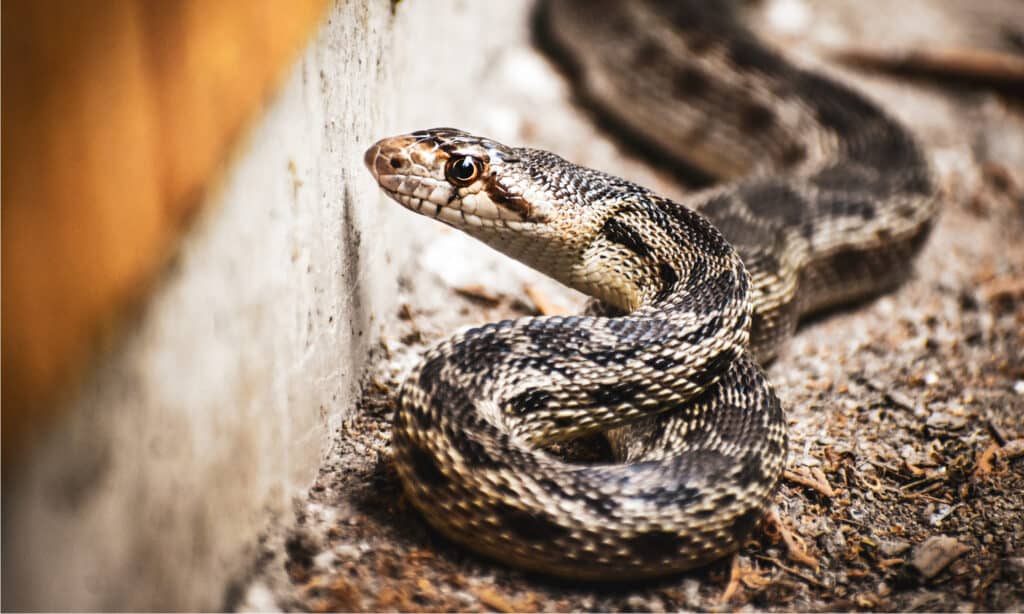
Gopher snakes are the most common nonvenomous snake and the second most common snake in Arizona overall.
©Cedar Dobson/Shutterstock.com
Long-Nosed Snake (Rhinocheilus lecontei)
The second most common nonvenomous snake in an Arizona garden is the long-nosed snake.
This beautiful snake has a couple of color morphs. One has black and red or orange saddles with light-colored spaces between them. The other lacks the red pigment in its scales; it looks like a California king snake – except for the red or orange irises. Long-nosed snakes are on the smaller side and don’t typically exceed three feet long.
Long-nosed snakes are widespread and found in western and southern Arizona’s flatlands and valleys. Like other snakes, these snakes follow the food — which is mostly whiptail lizards, but also mice, rats, and eggs. It prefers desert scrub and semidesert grassland and is almost entirely nocturnal.

Long-nosed snakes are widespread and found in western and southern Arizona’s flatlands and valleys.
©jokerbethyname/Shutterstock.com
Coachwhip (Masticophis flagellum)
Coachwhips are known diurnal snakes. They actively hunt their favorite prey even on hot days that send other snakes for shelter from the heat. This long, thin species gets its name from the braided, whiplike appearance of their scales.
This is a snake that cruises through the brush and grasses with its head above the brush. It hunts as much by sight as by scent, and it is curious about everything. Coachwhips have even been known to cruise up to a person before beating a hasty retreat — which usually frightens the person and they think the snake is chasing them. Not so!
Young coachwhips have bands that fade into the base color as the snake matures. These snakes are long, often reaching six feet long. In Arizona, they exhibit a variety of colors from red or pinkish to orange, tan, brown, or even black. Their eyes are large for their heads and have round pupils, and coachwhips’ heads are smallish and not really distinct from their necks.
These are opportunistic and feed on just about anything. Snakes (even rattlesnakes), lizards, mice, rats, birds, eggs, insects, bats, frogs, and toads are part of their diet. Generally coachwhips like big open areas where they can periscope up to see over the grasses and brush.
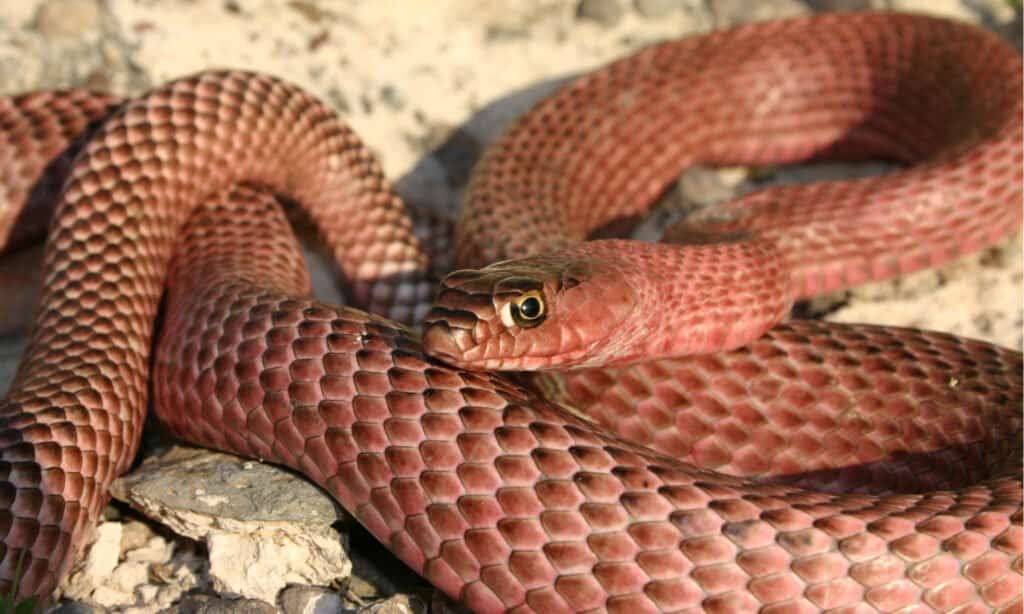
The western coachwhip cruises through the brush and grasses with its head above the brush, hunting as much by sight as by scent.
©Nathan A Shepard/Shutterstock.com
Other Arizona Garden Snakes
Arizona is home to dozens of snake species that aren’t venomous, including North America’s only boas! The landscape with all its nooks and crannies with plenty of prey hiding in them makes it an ideal habitat for snakes that enjoy a more arid habitat.
Here are a few species:
- Rosy boa (Lichanura trivirgata and Lichanura orcutti)— somewhat rare.
- California kingsnake (Lampropeltis californiae) — known to eat other snakes, including rattlesnakes!
- Desert kingsnake (Lampropeltis splendida)
- Several garter snakes including the western terrestrial, black-necked, and checkered(Thamnophis elegans, T. cyrtopsis, T. marciana)
- Sonoran lyre snake (Trimorphodon lamda)
- Desert night snake (Hypsiglena chlorophaea)
- Mexican hognose snake (Heterodon kennerlyi)
- Western patch-nose snake (Salvadora hexalepis)
Venom is More Widespread Than We Thought!
A few snakes are technically venomous, but not dangerous to people. However, their venom is so mild and prey-specific that it does not hurt people except in rare instances of an allergic reaction.
Garter snakes, hognose snakes, and night snakes fit into this category.
You always thought garter snakes were nonvenomous? So did scientists! It’s a recent discovery; we never noticed it before because no one has ever suffered serious consequences from a garter snake bite. Their venom is more of a ”venomous saliva” that they inject into prey via enlarged teeth in the back of their jaw.
Scientists are discovering that venom in snakes and lizards evolved more often than they previously believed, which is driving more research!
Some scientists think that hognose and garter snakes may also be poisonous because of the poisonous toads that are part of their diets. It’s an interesting idea, and may explain the hognose’s dramatic threat display. It may not be just playing dead — it could be warning the other animal that if they eat it, they could get sick.
Love them or hate them, snakes keep the rodent population at bay. Many species fall somewhere in the middle of the food chain, making them both predators and prey — and giving them all the reflexes of both.
Yet, as frightening as they are if you’re ophidiophobic, afraid of snakes, they know that in a fight with you, they always lose. They’d rather run, er, slither than fight and all you need to do is give them the space to do so.
The photo featured at the top of this post is © Joe Farah/Shutterstock.com
Discover the "Monster" Snake 5X Bigger than an Anaconda
Every day A-Z Animals sends out some of the most incredible facts in the world from our free newsletter. Want to discover the 10 most beautiful snakes in the world, a "snake island" where you're never more than 3 feet from danger, or a "monster" snake 5X larger than an anaconda? Then sign up right now and you'll start receiving our daily newsletter absolutely free.
Thank you for reading! Have some feedback for us? Contact the AZ Animals editorial team.






